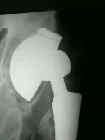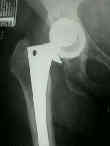- See: Osteolysis and Insertion of Polyethylene
- Discussion:
- originally Charnley used high density polyethylene and later this was changed to ultrahigh molecular weight polyethylene
- impact strength of UHMWPE is higher than that for HDPE and the density of UHMWPE is much lower than for HDPE;
- UHMWPE has better abrasion resistance, strength, resistance to deformation, and fatigue strength;
- resistance to wear:
- conformation of the bearing surfaces is important because it is factor in the determination of contact stress;
- increases in material strength, will usually result in increases in stiffness and increases in contact stresses;
- hence, it is important that gains in gains in strength offset increases in surface contact;
- increases in the modulus of the polymer (or increases in the density) will have effect of increasing contact stress and may result in increased wear;
- higher contact stresses between ultra-high molecular wt poly & other biomaterials are thought to result in greater polymeric wear;
- over the lifetime of an implant, polyethylene becomes stiffer near the surface, and therfore, contact forces will increase w/ time;
- incongruent contact:
- occurs from the "round on flat" contact of some early total knee designs;
- these systems attempted to re-create normal knee kinematics;
- these knee systems induce high contact stresses in the polyethylene component which leads to wear;
- ref: Conventional Versus Cross-Linked Polyethylene for Total Hip Arthroplasty
- thermoplastic properties:
- deformation of polyethylene is dependent on temperature;
- heat pressing alters physical properties of polyethylene near surface of component and makes device more susceptible for fracture
at the subsurface juncture of heat-press material and the bulk polyethylene;
- sterilization methods:
- gas plasma
- ethylene oxide
- gamma sterilization:
- sterilization in air may be particularly harmful, because it may initiate a long term oxidative process which has a negative impact
on the implant's mechanical properties, and which can dramatically increase the propensity for volumetric wear;
- shelf aging may cause oxidation and free radical formation of insert;
- direct molded 1900 resin may have less oxidation than other methods;
- tibial inserts may be more prone to oxidation that acetabular inserts;
- radiation induced polyethylene cross linking;
- w/ low O2 environment, free radicals created during irradiation can form carbon-carbon cross-links between polyethylene molecules;
- cross-linking improves the wear resistance of the polymer;
- radiation causes decreases in the poly mechanical properties (decrease in ultimate tensile strength, fracture toughness, and resistance to crack propagation);
- subsequent heating of acetabular polyethylene cups (melting / annealing) after irradiation may reduce level of residual free radicals, which reduces oxidation;
- application of vitamin E also stabilizes the free radicals and reduces potential for oxidation;
- in the study by McKellop H, et al, a hip-joint simulator was used to assess whether it is preferable to sterilize ultra-high molecular weight
polyethylene cups w/o gamma irradiation, to avoid radiation-induced oxidative degradation, or to sterilize with gamma while cups are
packaged in a suitable low-oxygen atmosphere to minimize oxidation while retaining increased wear resistance conferred by radiation-induced
crSome manufacturers take the additional step of heating acetabular polyethylene cups after irradiation to reduce the level of
residual free radicals, thereby reducing subsequent oxidationss-linking;
- irradiation while the cups are packaged in a suitable low-oxygen atmosphere to minimize oxidation while retaining increased
wear resistance conferred by the radiation-induced cross-linking;
- results of the present study demonstrated that the cross-linking induced by gamma irradiation improves wear resistance of ultra-high
molecular weight polyethylene, while oxidation reduces it;
- sterilizing with use of gamma irradiation with the implant packaged in a low-oxygen atmosphere avoids immediate oxidation and
cross-links the polyethylene, thereby increasing its wear resistance, but long-term oxidation of the residual free radicals
may markedly reduce the wear resistance;
- references:
- Effect of sterilization method and other modifications on the wear resistance of acetabular cups made of ultra-high molecular weight polyethylene. A hip-simulator study.
- Study of fatigue resistance of chemical and radiation crosslinked medical grade ultrahigh molecular weight polyethylene.
- Fatigue crack propagation resistance of highly crosslinked polyethylene.
- Gamma irradiation alters fatigue-crack behavior and fracture toughness in 1900H and GUR 1050 UHMWPE.
- Polyethylene Wear in TKR:

- Linear Wear in THR:
- wear is measured as smallest radius from the center of femoral head to outer border of the acetabuluar cup;
- ranges from 0.01 to 0.56 mm per year (avg about 0.29) but this often decreases with time to 0.15 mm per year after 9 years;
- linear wear increases w/ heavier pts and pts that exercise;
- 22 mm femoral heads have a greater amount of linear wear than do 28 mm heads;
- excessive wear may be associated w/ osteolysis, which may be more common w/ non-cemented components (Devane et al);
- this finding that ostelysis is more common in non-cemented components may be due to design characteristics of the cup or
may be due to the fact that thinner polyethylene cups were inserted w/ the non-cemented group;
- cement may also prevent the polyethylene debris from reaching the bone interface;
- as pointed out by Sychterz et al, it is important to measure the initial amount of "apparent linear wear" since this can measure
as much as 1.1 mm on the initial postop films;
- this may be a result of liner design and polyethylene plastic deformation, and should not be counted in final assessment
of volumetric wear;
- Radiographic Evaluation of Penetration by the Femoral Head into the Polythylene Liner over Time
- radiographic techniques:
- as noted by Smith PN, et al, it is important that films be taken wt bearing when measuring polyethylene wear;
- supine films will consistently underestimate polyethylene wear;
- in contrast, in the report by Moore KD, et al (2000), the authors found no evidence that radiographs must be taken w/ the patient
wt bearing (vs supine) in order to accurately measure the position of the femoral head within the polyethylene liner;

- references:
- The influence of weight-bearing on the measurement of polyethylene wear in THA
- The effect of weight-bearing on the radiographic measurement of the position of the femoral head after total hip arthroplasty.
- Volumetric Wear in THR:
- related in part to size of femoral head;
- lowest rate of volumetric wear can be found w/ 22 mm head, wear w/ 26 mm head is intermediate, and and highest rate of wear is found w/
32 mm heads (and result increase in osteolysis);
- as pointed out by Jasty M, et al (1997), the thickness of the polyethylene component is esp important in metal backed press fit components;
- w/ smaller acetabular components consider using a 26 mm rather than a 28 mm head;
- ref: Wear of polyethylene acetabular components in total hip arthroplasty. An analysis of one hundred and twenty-eight components retrieved at autopsy or revision operations.
The Otto Aufranc Award. Impact of gamma sterilization on clinical performance of polyethylene in the hip.
The natural history of ultra high molecular weight polyethylene.
Post-irradiation aging of ultra-high molecular weight polyethylene.
Radiographic Evaluation of Penetration by the Femoral Head into the Polythylene Liner over Time.
The influence of weight-bearing on the measurement of polyethylene wear in THA.
The Basis for a Second-generation Highly Cross-linked UHMWPE.
Nonsurgical Management of Osteolysis: Challenges and Opportunities.
Ex Vivo Stability Loss of Irradiated and Melted Ultra-High Molecular Weight Polyethylene
Comparative Survival of Uncemented Acetabular Components Following Primary Total Hip Arthroplasty
Radiostereometric analysis study of tantalum compared with titanium acetabular cups and highly cross-linked compared with conventional liners in young patients undergoing total hip replacement.

